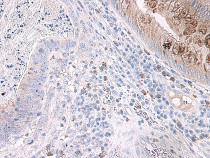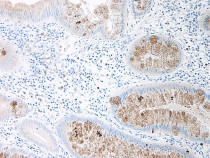ARG66039
anti-CCL15 antibody
anti-CCL15 antibody for ELISA,IHC-Formalin-fixed paraffin-embedded sections,Neutralizing,Western blot and Human
概述
| 产品描述 | Goat Polyclonal antibody recognizes CCL15 |
|---|---|
| 反应物种 | Hu |
| 应用 | ELISA, IHC-P, Neut, WB |
| 宿主 | Goat |
| 克隆 | Polyclonal |
| 同位型 | IgG |
| 靶点名称 | CCL15 |
| 抗原物种 | Human |
| 抗原 | E. coli derived recombinant Human CL15. (QFTNDAETEL MMSKLPLENP VVLNSFHFAA DCCTSYISQS IPCSLMKSYF ETSSECSKPG VIFLTKKGRQ VCAKPSGPGV QDCMKKLKPY SI) |
| 偶联标记 | Un-conjugated |
| 別名 | Small-inducible cytokine A15; SCYL3; LKN-1; 22-92; Chemokine CC-2; HMRP-2B; MIP-1 delta; NCC-3; 29-92; C-C motif chemokine 15; SY15; MIP-1D; MRP-2B; MIP-5; Leukotactin-1; NCC3; SCYA15; HCC-2; 25-92; Macrophage inflammatory protein 5; Mrp-2b; LKN1 |
应用说明
| 应用建议 |
|
||||||||||
|---|---|---|---|---|---|---|---|---|---|---|---|
| 应用说明 | IHC-P: Antigen Retrieval: Boil tissue section in Sodium Citrate buffer (pH 6.0) followed by cooling at RT for 20 min. * The dilutions indicate recommended starting dilutions and the optimal dilutions or concentrations should be determined by the scientist. |
属性
| 形式 | Liquid |
|---|---|
| 纯化 | Affinity purification with immunogen. |
| 缓冲液 | PBS (pH 7.2) |
| 浓度 | 1 mg/ml |
| 存放说明 | For continuous use, store undiluted antibody at 2-8°C for up to a week. For long-term storage, aliquot and store at -20°C or below. Storage in frost free freezers is not recommended. Avoid repeated freeze/thaw cycles. Suggest spin the vial prior to opening. The antibody solution should be gently mixed before use. |
| 注意事项 | For laboratory research only, not for drug, diagnostic or other use. |
生物信息
| 数据库连接 | |
|---|---|
| 基因名称 | CCL15 |
| 全名 | chemokine (C-C motif) ligand 15 |
| 背景介绍 | This gene is located in a cluster of similar genes in the same region of chromosome 17. These genes encode CC cytokines, which are secreted proteins characterized by two adjacent cysteines. The product of this gene is chemotactic for T cells and monocytes, and acts through C-C chemokine receptor type 1 (CCR1). The proprotein is further processed into numerous smaller functional peptides. Naturally-occurring readthrough transcripts occur from this gene into the downstream gene, CCL14 (chemokine (C-C motif) ligand 14). [provided by RefSeq, Jan 2013] |
| 生物功能 | Chemotactic factor that attracts T-cells and monocytes, but not neutrophils, eosinophils, or B-cells. Acts mainly via CC chemokine receptor CCR1. Also binds to CCR3. CCL15(22-92), CCL15(25-92) and CCL15(29-92) are more potent chemoattractants than the small-inducible cytokine A15. [UniProt] |
| 预测分子量 | 12 kDa |
检测图片 (3) Click the Picture to Zoom In
-
ARG66039 anti-CCL15 antibody IHC-P image
Immunohistochemistry: Formalin-fixed and paraffin-embedded sections of Human colon and rectum adenocarcinoma. The recommended ARG66039 anti-CCL15 antibody concentration is 0.5 µg/ml with an overnight incubation at 4°C. An HRP-labeled polymer detection system was used with a DAB chromogen. Antigen Retrieval: Boil tissue section in Sodium Citrate buffer (pH 6.0) followed by cooling at RT for 20 min.
-
ARG66039 anti-CCL15 antibody standard curve image
Sandwich ELISA: ARG66039 anti-CCL15 antibody as a capture antibody at 0.5 - 2.0 µg/ml combined with ARG66040 anti-CL15 antibody (Biotin) as a detection antibody. Results of a typical standard run with optical density reading at 405 - 650 nm.
-
ARG66039 anti-CCL15 antibody IHC-P image
Immunohistochemistry: Formalin-fixed and paraffin-embedded sections of Human colon and rectum adenocarcinoma. The recommended ARG66039 anti-CCL15 antibody concentration is 0.5 µg/ml with an overnight incubation at 4°C. An HRP-labeled polymer detection system was used with a DAB chromogen. Antigen Retrieval: Boil tissue section in Sodium Citrate buffer (pH 6.0) followed by cooling at RT for 20 min.










